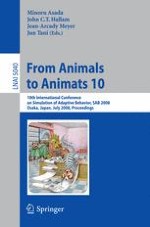2008 | Buch
From Animals to Animats 10
10th International Conference on Simulation of Adaptive Behavior, SAB 2008, Osaka, Japan, July 7-12, 2008. Proceedings
herausgegeben von: Minoru Asada, John C. T. Hallam, Jean-Arcady Meyer, Jun Tani
Verlag: Springer Berlin Heidelberg
Buchreihe : Lecture Notes in Computer Science
